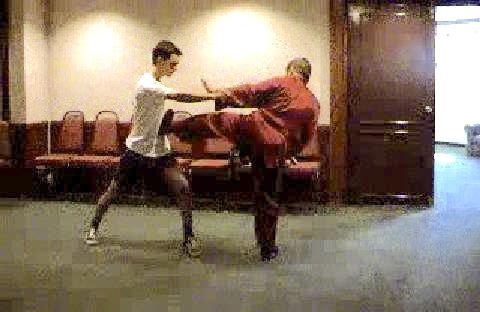IMPORTANT POINTS ABOUT KICKS

Right spacing is important in a kick
Question
What are the important points students of Shaolin Kungfu should know about kicks?
— Roger, Switzerland
Answer
Here are some important points about kicks.
There are more kicks in Shaolin Kungfu than all the kicks of other martial arts put together, but many people are ignorant of this fact, and some even have the mistaken concept that there are few or no kicks in Shaolin Kungfu, especially Southern Shaolin.
There are, for example, 36 Leg Techniques in Shaolin Kungfu, and all the known kicks of martial arts in the world can be found in these 36 Leg Techniques, but many of these kicks are not found in other martial arts.
Despite the great number of kicks in Shaolin Kungfu, Shaolin kicks are purposely made to be inconspicuous. They are unlike kicks in Taekwondo and Muay Thai where their executions are quite obvious. Shaolin kicks are generally low, in contrast to some martial arts where the higher a practitioner can kick the better he is regarded to be.
There is a kungfu saying, in Cantonese pronunciation, that "sau hai leong moon seen, chun pang keok ta yen", which may be explained as "hands are like the two swings of a door, it is kicks that defeat an opponent."
There is another saying that "khuen ta sam fen, keok thaik cheat fen", which can be translated as "30% of victory depends on the hands, 70% of victory depends on the legs".
These two sayings show how important are footwork and kicks in kungfu. Many kungfu practitioners are not only unaware why footwork and kicks are important, they are not even aware that these sayings exist. Their ignorance is manifested when they execute high kicks without knowing their limitations, their poor balance and their blatant exposure to counter-attack even when their opponents may not actually counter-attack.
When you execute a high kick at an opponent's head, for example, not only you expose your groin but also you have bad balance and it is more difficult for you to retreat to safe defence when your opponent counter-attacks. Saying "See who is faster", as boasted by some exponents who use high kicks recklessly, indicates their lack of understanding combat philosophy.
There are a few innate weaknesses of kicks that exponents should know. These weaknesses are innate, which means that even the kicks are executed skilfully the weaknesses are still there.
- An exponent has to prepare himself to kick, like shifting his weight, and bending his body, thus giving some clear signals for a skilful opponent to know.
- While a kick is being executed, other parts of the body that can be used for striking an opponent, like the fists, the head, the shoulders, the elbows, the thigh and the knees -- i.e. the other six of the "seven stars" for attacking -- are not functional.
- The range of variation of a kick is limited. For example, if an opponent catches your leg when you kick, the range of variation is less than that of your hand when you strike. If your hand is caught, you can release it more readily, counter-grip your opponent, follow through with an elbow strike, or fell your opponent to the ground followed with a coup de grace.
- If an opponent strikes your kicking leg, it is harder to defend than if he strikes your attacking hand. It is also harder for your opponent to counter-strike when you strike with your hand because you can cover him with your other hand as you attack, but you are unable to do so when you kick.
- If your opponent avoids your kick and counter-attacks your body, you have to retreat your kick before you can implement some safe defence. You don't have this extra retreating movement when you strike.
Kungfu exponents who use kicks should understand these innate weaknesses as well as common counters against kicks, so that they know what to do when their opponents exploit their kicks.
Yet, despite these innate weaknesses, kicks are used, inconspicuously, to win combat. The hands are used to open the way for the kick -- a fact that many who use kicks routinely may not know.
The above is taken from Question 2 July 2016 Part 3 of the Selection of Questions and Answers.
LINKS
Courses and Classes
